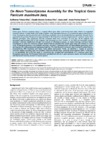Please use this identifier to cite or link to this item:
http://www.alice.cnptia.embrapa.br/alice/handle/doc/981465| Title: | De novo transcriptome assembly for the tropical grass Panicum maximum Jacq. |
| Authors: | SILVA, G. T.  SILVA, C. B. C.   JANK, L.   SOUZA, A. P.   |
| Affiliation: | GUILHERME TOLEDO-SILVA, Molecular Biology Center and Genetic Engineering (CBMEG), University of Campinas (UNICAMP), Campinas, São Paulo, Brazil. CLAUDIO BENICIO CARDOSO-SILVA, Molecular Biology Center and Genetic Engineering (CBMEG), University of Campinas (UNICAMP), Campinas, São Paulo, Brazil LIANA JANK, CNPGC ANETE PEREIRA SOUZA, Molecular Biology Center and Genetic Engineering (CBMEG), University of Campinas (UNICAMP), Campinas, São Paulo, Brazil Department of Plant Biology, Biology Institute, University of Campinas (UNICAMP), Campinas, São Paulo, BraziL. |
| Date Issued: | 2013 |
| Citation: | PLOS ONE, v. 8, n. 7, p. 1-10, july 2013 |
| Description: | Guinea grass (Panicum maximum Jacq.) is a tropical African grass often used to feed beef cattle, which is an important economic activity in Brazil. Brazil is the leader in global meat exportation because of its exclusively pasture-raised bovine herds. Guinea grass also has potential uses in bioenergy production due to its elevated biomass generation through the C4 photosynthesis pathway. We generated approximately 13 Gb of data from Illumina sequencing of P. maximum leaves. Four different genotypes were sequenced, and the combined reads were assembled de novo into 38,192 unigenes and annotated; approximately 63% of the unigenes had homology to other proteins in the NCBI non-redundant protein database. Functional classification through COG (Clusters of Orthologous Groups), GO (Gene Ontology) and KEGG (Kyoto Encyclopedia of Genes and Genomes) analyses showed that the unigenes from Guinea grass leaves are involved in a wide range of biological processes and metabolic pathways, including C4 photosynthesis and lignocellulose generation, which are important for cattle grazing and bioenergy production. The most abundant transcripts were involved in carbon fixation, photosynthesis, RNA translation and heavy metal cellular homeostasis. Finally, we identified a number of potential molecular markers, including 5,035 microsatellites (SSRs) and 346,456 single nucleotide polymorphisms (SNPs). To the best of our knowledge, this is the first study to characterize the complete leaf transcriptome of P. maximum using highthroughput sequencing. The biological information provided here will aid in gene expression studies and marker-assisted selection-based breeding research in tropical grasses. |
| Thesagro: | Panicum maximum Alimento animal Graminea tropical Carne |
| NAL Thesaurus: | Beef cattle Megathyrsus maximus |
| Type of Material: | Artigo de periódico |
| Access: | openAccess |
| Appears in Collections: | Artigo em periódico indexado (CNPGC)  |
Files in This Item:
| File | Description | Size | Format | |
|---|---|---|---|---|
| debpone.00707811..10fetchObject.action.pdf | 6.18 MB | Adobe PDF |  View/Open |









